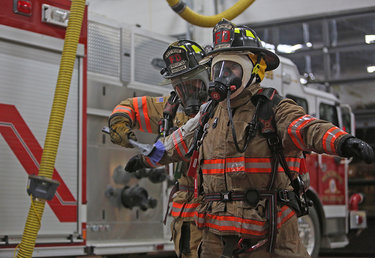Cancer-preventing protocols demonstrated by Westmere firefighters
GUILDERLAND — Everyone knows firefighters risk injury and even their lives quelling blazes.
But what is lesser known is they also run a greater risk than the general public of developing cancer.
According to two studies conducted by the National Institute for Occupational Safety and Health, firefighters are diagnosed with cancer at a 9-percent higher rate than the general public and die from cancer at a 14-percent higher rate.
One of the studies, of nearly 30,000 career firefighters from Chicago, Philadelphia, and San Francisco who were employed between 1950 and 2009, states, “There are approximately 1.1 million volunteer and career firefighters in the U.S. During firefighting activities, these workers may be exposed to many known carcinogens (eg, polycyclic aromatic hydrocarbons (PAHs), formaldehyde, benzene, 1,3-butadiene, asbestos and arsenic) in volatilised combustion and pyrolysis products or debris.”
Additionally, firefighters can carry these toxins into their homes, exposing the people with whom they live.
New York State’s Office of Fire Prevention and Control has begun training firefighters on how to protect themselves and their families. State Fire officials have developed decontamination kits to reduce the chances that firefighters carry harmful chemicals to their firehouses and homes, potentially cross-contaminating co-workers and family members.
A demonstration for Albany County firefighters was given on Monday at the Westmere firehouse in Guilderland. Two Westmere volunteers went through the process that ideally each firefighter would do at the scene of a fire after their work fighting the fire was done.
Heather Harris, dressed in full gear, including a mask and self-contained breathing apparatus, held her arms out while Brian Hausman used a hose spraying water in a fog pattern over every inch of her, front and back, including her boots and gloves.
Next, using a spray bottle filled with a mixture of dish soap and water, Hausman scrubbed the same areas with a soft brush, and then sprayed again. Special wipes, which are included in the kit for firefighters along with the spray bottle and hose, and two brushes, are then used to wipe down the face, neck, hands, and wrists.
All of the gear is then to be placed in state-supplied plastic bags so as not to contaminate the fire truck. Once back at the firehouse, a firefighter then washes the gear inside and out. Firefighters should then shower and put on clean clothes.
According to a release from the governor’s office, announcing the decontamination protocols, this process removes 85 percent of the toxins.
State Fire officials initially launched a similar outreach program in early 2020, which was placed on hold due to the pandemic, the governor’s office said. The new initiative, launched last month, is to raise awareness among the fire service on how to use these life-saving protocols for cancer prevention, and to support those who’ve already received a cancer diagnosis within their fire departments.
The state has produced a video to explain the process.
“We are thrilled to continue our program educating members of the State Fire Service on immediate steps they can take to protect themselves following an incident response,” said New York State Fire Administrator Jim Cable in the release. “Sadly, cancer is now the leading cause of firefighter deaths in the nation. Our goal is to reduce occupational illness by educating our brothers and sisters in the fire service on specific measures they can take to reduce exposure to contaminants and lower their health risks.”



